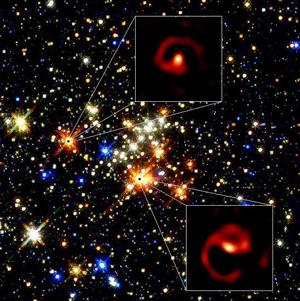Yin and Yang emerge from solar swirl

Out there … the double stars.
Photo: Sydney University Physics Depart
MASSIVE pairs of stars that produce dust spirals resembling giant cosmic Yin and Yang symbols have been discovered at the centre of our galaxy.
The find, by a Sydney astronomer, Peter Tuthill, solves a 15-year-old mystery. Dr Tuthill, of the University of Sydney, said that observing stars at the heart of the Milky Way was like trying to see a tree in the centre of a forest. "It's heavily obscured."
A group of stars known as the Quintuplet Cluster has puzzled astronomers since it was first seen in 1990 next to the black hole at the galaxy's core. Dr Tuthill and his colleagues used the world's biggest telescope - the 10-metre Keck in Hawaii.
They found that each of the five dust-covered red stars that give the cluster its name is a rare type of double star system nearing the end of its life.
As the short-lived duo of massive stars swirl around each other, their winds collide, producing a pinwheel of dust far bigger than our solar system, in the same way that a twirling garden sprinklers produce a pinwheel of water.
"It looks like a Yin and Yang," said Dr Tuthill, whose research was published in the journal Science yesterday.
Massive stars are not found in the suburbs of the galaxy, where we live, he said. "To find them you have to go downtown, where the lights are bright," near the galaxy's centre.
Understanding their nature was important because they had such a big impact on the evolution of the cosmos, he said. "They really shove their weight around."
When they reach the end of their lives each of the Quintuplet Cluster star pairs will produce three massive explosions, or supernovae, that will blast the heavier elements needed for forming planets around smaller stars, out into space.
A team member, Donald Figer of the Rochester Institute of Technology in New York State, said only a few other pinwheel star systems had been spotted in our galaxy. "We've found five all next to each other in the same cluster. No one has seen anything like this before."
SAVE 33% on home delivery of the Herald - subscribe today





